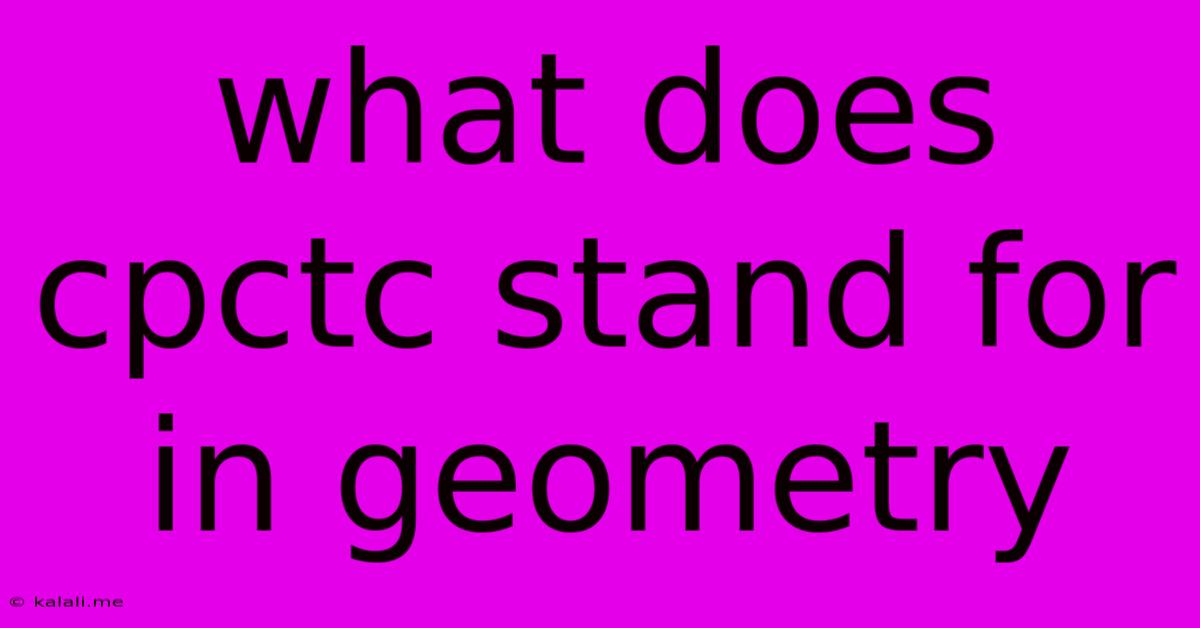What Does Cpctc Stand For In Geometry
Kalali
May 10, 2025 · 3 min read

Table of Contents
What Does CPCTC Stand For in Geometry? Unlocking the Secrets of Congruent Triangles
Have you ever encountered the acronym CPCTC in your geometry studies and wondered, "What does CPCTC stand for?" This seemingly cryptic abbreviation is actually a fundamental concept in proving triangle congruence. Understanding CPCTC is crucial for mastering geometric proofs and solving complex problems involving congruent figures. This article will break down the meaning of CPCTC, explain its significance, and provide examples to solidify your understanding.
CPCTC stands for Corresponding Parts of Congruent Triangles are Congruent. This seemingly simple statement holds immense power in geometric proofs. It essentially states that if two triangles are proven congruent (meaning they have the same size and shape), then all their corresponding parts – sides and angles – are also congruent.
Understanding Congruence and Corresponding Parts
Before diving deeper into CPCTC, let's refresh our understanding of triangle congruence. Two triangles are considered congruent if they meet one of the following congruence postulates:
- SSS (Side-Side-Side): If all three sides of one triangle are congruent to the corresponding sides of another triangle.
- SAS (Side-Angle-Side): If two sides and the included angle of one triangle are congruent to the corresponding sides and included angle of another triangle.
- ASA (Angle-Side-Angle): If two angles and the included side of one triangle are congruent to the corresponding angles and included side of another triangle.
- AAS (Angle-Angle-Side): If two angles and a non-included side of one triangle are congruent to the corresponding angles and non-included side of another triangle.
- HL (Hypotenuse-Leg): Specifically for right-angled triangles, if the hypotenuse and one leg of one triangle are congruent to the corresponding hypotenuse and leg of another triangle.
Once you've established congruence using one of these postulates, CPCTC allows you to immediately deduce the congruence of all corresponding parts. This significantly simplifies proofs, eliminating the need to individually prove the congruence of each side and angle.
How CPCTC Works in Geometric Proofs
CPCTC is typically used in the final steps of a geometric proof. You first use one of the congruence postulates (SSS, SAS, ASA, AAS, or HL) to prove that two triangles are congruent. Then, you can use CPCTC to state that any corresponding parts of those triangles are congruent.
Example:
Let's say you've proven that triangle ABC is congruent to triangle DEF using the SAS postulate. You can then use CPCTC to state the following:
- AB ≅ DE
- BC ≅ EF
- AC ≅ DF
- ∠A ≅ ∠D
- ∠B ≅ ∠E
- ∠C ≅ ∠F
Common Mistakes to Avoid When Using CPCTC
A common mistake is trying to use CPCTC before proving triangle congruence. Remember, CPCTC is a consequence of proven congruence, not a method for proving it. You must first establish congruence using one of the postulates before you can apply CPCTC.
Another potential pitfall is incorrectly identifying corresponding parts. Ensure you carefully match the vertices of the congruent triangles to correctly identify corresponding sides and angles.
CPCTC: A Cornerstone of Geometry
In conclusion, understanding what CPCTC stands for and how to apply it effectively is essential for success in geometry. It streamlines proofs, allowing for more efficient and elegant solutions to complex problems. By mastering this fundamental concept, you’ll unlock a deeper understanding of geometric relationships and enhance your problem-solving skills. Remember: prove congruence first, then leverage the power of CPCTC!
Latest Posts
Latest Posts
-
Step Up To The Streets Final Dance
Jul 06, 2025
-
How Many Grams Is Half An Oz
Jul 06, 2025
-
How Much Is 10 Quarters In Dollars
Jul 06, 2025
-
How Do You Beat Stage 9 On Bloxorz
Jul 06, 2025
-
What Is 1 2 Equivalent To In Fractions
Jul 06, 2025
Related Post
Thank you for visiting our website which covers about What Does Cpctc Stand For In Geometry . We hope the information provided has been useful to you. Feel free to contact us if you have any questions or need further assistance. See you next time and don't miss to bookmark.